Forgotten Fruits, part 1
By martha
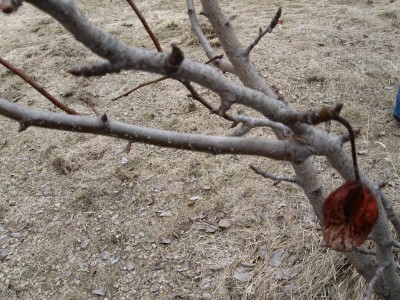
Fact One: The first edition of The Nomenclature of the Apple, published by USDA pomologist W.H. Ragan in 1905, lists 6,554 uniquely named apple varieties then grown in the United States. One hundred years later Wisconsin orchard-keeper Dan Bussey, whose exhaustive history of American apples is due out in 2010, estimates the true number at 16,000 — more than twice Ragan’s count.
Fact Two: Today, that number stands at, oh, 1,500.
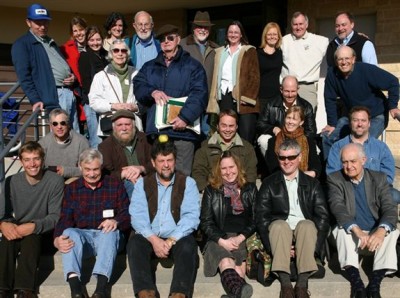
The RAFT gathering in Madison kept returning to the magnetic north of these numbers. Where did all the apples go? When did they disappear? Why??? And what was going on in the 19th century – the “golden age” of apples in America – to seed such biodiversity in the first place?
Thursday, March 19, I hustled into Harvest Restaurant 15 minutes late for a dinner honoring what Gary Paul Nabhan toasted that night as “the Buena Vista Social Club of apple growers” (pictured above). Keepers of heritage orchards scattered across the states, many of these men (they were mostly men) had never before met in person – and it was entirely possible they well might never again.
The apple growers had put their heads together earlier that day at the “Forgotten Fruits Summit,” convened by RAFT with a mandate at once particular and sweeping: “To determine the best means of restoring apple diversity to our farms, roadhouses, backyards and kitchens, and to revive ‘apple culture’ in all its dimensions on this continent.” (To read Nabhan’s wrap-up of the summit and its various adjunct events, go here.)
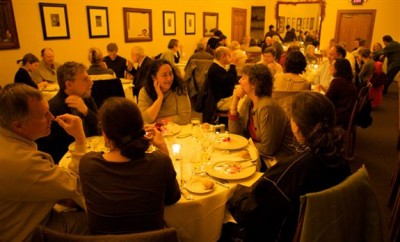
Not being an heritage apple guru, I wasn’t part of the summit. But I got to tag along to the eating—and drinking–part afterward. At Harvest that night we sampled nine ciders: seven hard, two sweet, and all from Wisconsin or Michigan. Honestly, it was revelatory.
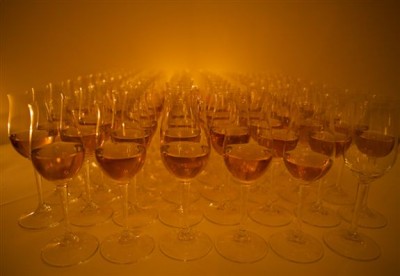
I’ve always been a cider fan. I’ve even made my own — but it’s usually turned out on the thin side. Or gone to vinegar. But the best stuff that night was as richly complex as, if not a vintage Champagne, at least a quality Chablis. One of my faves was a sweet, effervescent hard cider from White Winter Winery in Iron River. Another hard one, from Zydeco Cider in Viola, WI, had a distinctive bitter bite, maybe a touch tannic from the skins. Both, IMHO, dominated a more refined, “English-style” cider from Michigan’s Tandem Cider. All three were paired with a first course of beet, fennel, and grapefruit salad; crispy potato croquetas; La Quercia prosciutto with pickled apple; and an oozy node of Saxon Creamery’s buttery Big Ed’s atop an apple-flavored graham cracker.
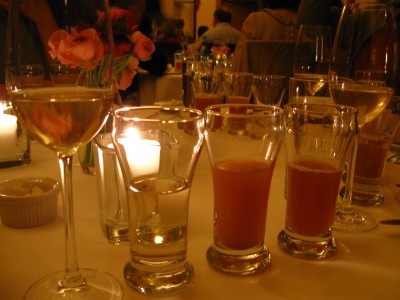
The two sweet (ie: nonalcoholic) ciders that came next were decidedly robust. I swore I could taste each individual apple in the rich unfiltered cider from Seedlings (of Fruit Slinger fame), while Dan Bussey’s “mixed debris” cider, pressed from, he guessed, 15 varieties of apple (aka “whatever’s left over at the end of the season”) was musty, funky, and downright weird – in the very best possible way. These, along with more hard ciders from Aeppel Treow and Uncle John’s Fruit House, washed down a second course of duck confit and sunchoke puree; a much-too-small pulled pork sandwich (damn tasting menu); a slice of La Quercia coppa, and a schmear of smoked trout and horseradish cream on a surprising caraway cracker.
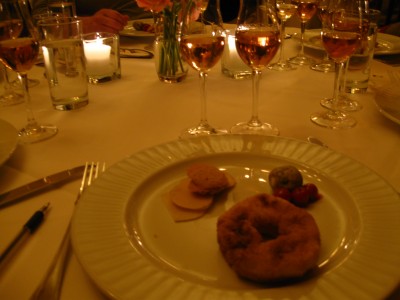
For dessert (above) we got healthy pours of Aeppel Treow’s Pommeaux , a 19% knockout of a dessert wine made by fortifiying sweet cider with apple eau de vie, and another dessert wine from Uncle John’s, in St. John’s, Michigan. Unfortunately, by this point my note-taking skills were somewhat compromised and I don’t have anything to go on for this one but “sweet” and “wow!” But, I guess that says a lot for a dessert wine, right?
On the food end here we got an awesomely hot, fresh zeppole — a knot of deep-fried dough dusted with cinnamon sugar; a nugget of Hook’s blue cheese with walnuts and sour cherry jam; and a honey Madeline paired with crisp slices of some Newtown Pippins that “Fruit Detective” David Karp had confiscated from the summit earlier that day and then bestowed upon the kitchen. (And btw you should really check out the John Seabrook story linked above on Karp, who was pointed out to me at the dinner as “the famous fruit writer” and who is both a teetotaler — for reasons apparent in the Seabrook piece – and keeps kosher. I’m sort of dying to read whatever he may write about this dinner, which for him appeared to consist of sweet cider and an arugula salad.)
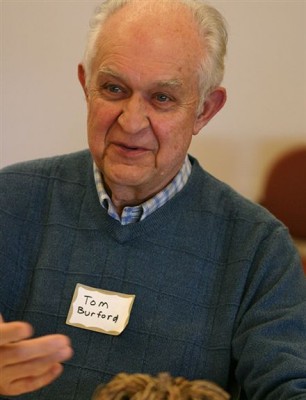
Somewhere near the end of all this, Tom Burford, the generally acknowleged capo di tutti capo of these fruit farmers, got up and told a little story about the celebrated Pippin, one of the original American apples, cultivated by both George Washington and Thomas Jefferson. Tart, homely, and slow to ripen, the Newtown (or Albemarle) Pippin is a hardy apple whose flesh mellows as it ages into a crisp, juicy fruit with a rigorous acidity. Back in the day, held up uncommonly well through transatlantic shipping — so well that it became a favorite of Queen Victoria, who in turn lifted the duty on them and allowed them to come into England tax-free. Thus underpriced, they flooded the London markets and became wildly popular, to the point that in the 18th century more Pippins making their way to England than to Albemarle County kitchens. Nowadays the Pippin’s star is dwarfed by the equally hard, tart, Granny Smith. It’s kept alive largely by the investment of the Martinelli’s cider family, which buys 85 % of the nation’s Newtown Pippin crop. (This is all also covered well in this NYT piece from five years ago.)
It’s a good story, illustrative perhaps of the power of celebrity endorsements and corporate sponsorship, even in the apple world. But it’s better if you can imagine it in Burford’s courtly Virginia accent.
Listening to Burford talk I had the first inkling of what would become abundantly clear the following day – that the story of apples is one that’s uniquely embodied in its farmers, cidermakers, orchardists, botanists, and cooks. And if we want the story to endure we’d better hustle up and write it down, because those bodies aren’t getting any younger.
To be continued … hopefully vaguely soon.
I stopped by after seeing you mentioned our rooftop growing experiment. Thanks for the link.
It’s not just the people who know how to do this that are fading away. The genetic source of the apple, in Central Asia, is threatened by the usual suspects: http://www.eurotrib.com/?op=displaystory;sid=2009/5/8/15117/70147